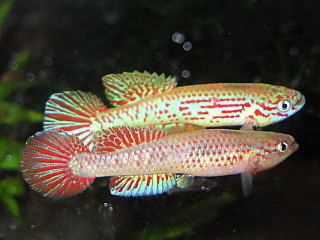| Meaning
of Name |
After
Werner Herzog, a German aquarist who discovered the species. |
| First
Description |
Radda
A.C. 1975. Contribution to the knowledge of
the Cyprinodonts of Gabon, with the description of four new species and one new
subspecies of the genus Aphyosemion Myers. Killi-News
118 (Seperate): 5-6, plates 10-11. (BKA) |
| Size |
4 cm (Radda & Pürzl 1987) |
| Meristics |
- D = 12-13, A = 13-14, ll = 29-30(+2) (Radda 1975)
- D
= 10-13, A = 12-14, ll = 29-31(+2) (Radda & Pürzl 1987)
|
| Karyotype |
n = 17, A = 34 (Scheel 1981) |
| Sub-Genus |
Mesoaphyosemion |
| Group |
herzogi (originally
placed in the calliurum group). |
| Synonyms |
- Aphyosemion calliurum
ahli (non Myers 1933) Lambert & Géry 1968
- Aphyosemion
batesii (non Boulenger 1911) Roman 1971
- Aphyosemion
bochtleri Radda 1975
- Aphyosemion
herzogi bochtleri Radda & Pürzl 1987
- Aphyosemion
herzogi herzogi Scheel 1990
|
Populations
- Akoga (northwestern
Gabon)
- Asseng
- Assok (northern
Gabon)
- Doumandzou
- Ebebiyin,
Rio Mami (Equatorial Guinea)
- Essong-Medzom
(north
- ern Gabon)
- Médouneu
- Mintoum (northern
Gabon)
- Nsessoum
- Ovan
- Zomoko (northern
Gabon) GBG 92 / 26
- BSW 99 / 12
-
- EMS 90 / 5 - Nsessoum
- EMS 90 / 6
- Bikong, 3 km north of Ambam
- GBG 93 / 32
- GBHL 86 / 1
- GEB 94 / 25 -
Edoum (aff.herzogi)
- GEMHS 00 / 7 - Acoc
- GEMHS 00 / 10
- GEMHS / 00 / 12 - Mbam
- GEMHS 00 / 15
- Acoesi
- GEMHS 00 / 16
- 1 km south of Nsoc
- GEMHS 00 / 18
- Rio Monto
- GEML 00 / 5 - Yama
- GEML 00 / 7 - Soha
- GEML 00 / 8 - Otong-Alam
- GEMLB 02 / 3
- Ayene
- GEMLB 02 / 7
- Bandili
- GEMLB 02 / 24
- Mikien
- GEMLB 02 / 25
- GEMLBJ 03 / 08 - Near Nsoc-Nsomo
- GEMLBJ 03 / 12 - Minang
- Essandong
- GEMLBJ 03 / 13 - Ndiva
creek, near Aloan
- GEMLBJ 03 / 15 - near
Nvom
- GEMLBJ 03 / 20
- GEMLBJ 03 / 27 -
(aff. herzogi)
- GEMLBJ 03 / 30 - Ayene
- GEMLC 04 / 9
- GEMLCG 07 / 23 - Sork
- Oveng
- GHG 83 / 2
- GWW 86 / 11 - Mintoum
- JH 76 / 48
- JH 76 / 52 - Medouneu
catholic Mission
- JH 76 / 54 -
Akoga
- JH 76 / 55 -
Song, 6 km north of Mela, aff. herzogi
- JH 79 / 227 - 21
km east of Oyem
- JH 79 / 229 - Mikongo
- K 98
- LEC 93 / 1
- LEC 93 / 19
- Avang
- LEC 93 / 22 - N
Song (aff.herzogi)
- LEC 93 / 25
- PEG 93 / 15
- PEG 94 / 18
- PEG 94 / 21 - Mobolo
- PEG 94 / 35
- Akam Efak, 25 km sth of Bitam, (aff.herzogi)
- PEG 94 / 37
- Mbono
- PEG 94 / 38 - Adzap (aff.herzogi)
- PEG 94 / 40 - Bindzima,15
km SW of Bibasse (aff.herzogi)
- PEG 94 / 42 - Egnieng Melen,
7 km east of Medouneu, (aff.herzogi)
- PEG 94 / 46 - Anzem (aff.herzogi)
- RPC 78 / 28
|
|
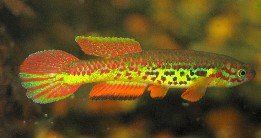
GEMLBJ
03/30 - f1
Photo courtesy of Mögens
Juhl
|
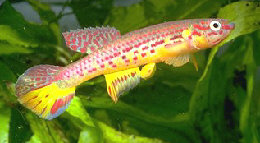
Photo courtesy
of Maurice Chauche & the KCF website.
|
_Ovan_Purzl.jpg)
Ovan. (bochtleri)
Wild male.
Photo courtesy of Ed Pürzl
|
GEMHS 00 - Collected by Dr. F. Malumbres,
J. Sanjuán, G-J. van Huijgevoort in 2000 in locations 7, 9, 10
& 12.
|
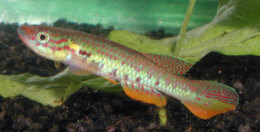
GEMHS 00 / 7
Photo courtesy of Vasco Gomes
|
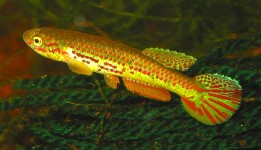
GEMHS 00/10 Yama
Photo courtesy of Mögens
Juhl
|
|
GHG 83/2 - Type locality. Imported as
A.bochtleri.
GWW 86 / 11
http://www.garysfishroom.us
Gary Bartell's site. This was a revisited site about 300 metres north
of Mintoum on the road from Ovan to Makokou. A.bochtleri
was described from this point. Other species collected included A.cameronense
& E.neumanni.
|
|
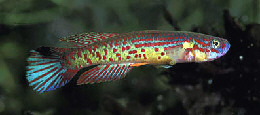
Distributed
as A.bochtleri GWW 86
/ 11.
Photo courtesy of Gunther Schmaus.
|
|
K 98 - K standing for Koubeck.
He collected commercially for a few years mainly in Gabon. These were
marketed in South Africa at least & were purported to have been
collected at the type locality. Distributed as A.bochtleri.
|

K 98. Photo
courtesy of Tyrone Genade
|
RPC 78 - Collected at location
28. Photos below may be from the RPC collections. The Lennie MacKowiak
pics are most likely to be from this collection.
|
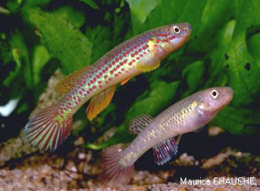
Distributed
as A.bochtleri.
Photo courtesy of Maurice Chauche & the
KCF website.
|
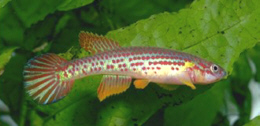
Distributed
as A.bochtleri.
Photo courtesy of Maurice Chauche & the
KCF website.
|
|
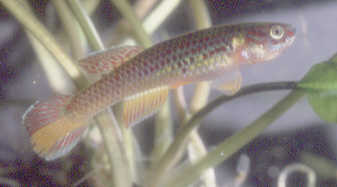
A.herzogi
circulating in the US around 1980. Photo: Courtesy of Lennie
MacKowiak
|
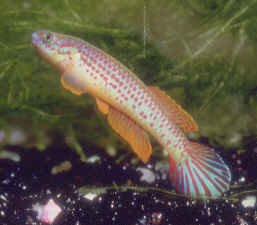
A.herzogi
circulating in the US around 1980. This form was distributed
under the synonym A.bochtleri. Photo: Courtesy of Lennie
MacKowiak
|
Zomoko - http://www.garysfishroom.us
Gary Bartell's site. Zomoko http://www.nakashima.org/gaphyosemion
Japan Gallery
|
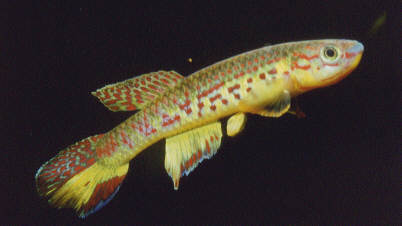
Zomoko.
Wild male.
Photo courtesy of Ed Pürzl
|
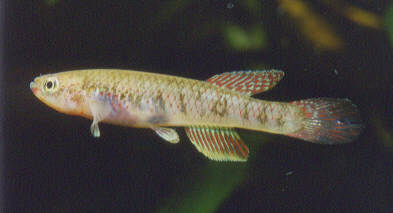
Zomoko.
Wild female.
Photo courtesy of Ed Pürzl
|
|
|
| Type
Locality |
3 km north of Zoumoukou (Zomoko) / 16 km north
of Lalara on the road to Mitzic & Oyem, northern Gabon. GHG 83/2.
|
| Distribution |
The inland plain of northern Gabon, southern Cameroon
& eastern Equatorial Guinea. Found in the Ivindo (upper), Mvoung (middle)
& Okano (middle) River drainages of northern Gabon. In southern Cameroon they
are found in the Ntem River drainage. In eastern Equatorial Guinea they inhabit
the Benito River drainage. |
| Habitat |
Collected in mountain brooks between Mitzic & Lalara.
The water was clear & occasionally fast flowing. Wild
fish have been found not to take aquatic foods, instead relying on a diet of terrestrial
insects (Amieti 1987). |
| Distinguishing
Characteristics |
The
caudal fin in some specimens is split, with the upper half dark &
the lower half yellow with a marginal band of pale blue. Other specimens
have a pale blue caudal with lines of red radiating outwardly. The anal
fin in both forms is a solid orange/yellow sometimes with a vague outer
margin of pale blue.
Females can be very colourful. See photo at the head of this page as an
example. |
| Colour/Pattern
Variability |
Fairly
high. |
| History |
Discovered by Werner Herzog & Franz Bochtler
in 1972.
Opinions have varied over the years concerning
the validity of A.bochtleri. It
is currently the generally accepted opinion that A.bochtleri
is a synonym of A.herzogi.
On the 10th January 1986 Wagner & Wendel collected a form in the
village of Bindzima (Bidzima on some maps), 13km southwest of Bibassé
(Bibas) on the road to Sam, northern Gabon. This was coded GWW 86/18.
It was considered a transitional form between both species. Unfortunately
this collection did not survive the journey back to Europe. I don't
think a photo exists of this collection.
|
| Breeding
Notes |
This
species is one one the harder species of the genus to breed & are not recommended
for the novice killie keeper. Males can be aggressive towards females & a
larger tank with plenty of plant/mop/fibre is recommended. If possible use 2-3
females. Eggs can be left in the breeding tank which, along with the fry are left
alone by the parents. As these fry grow they should be taken out & raised
in seperate aquaria. Incubation time in water
is 12-14 days. Newly hatched fry are capable of eating newly hatched brine shrimp.
They are slow growing & can take 7-8 months to reach sexual maturity, &
this after regular water changes.
Ian Sainthouse in BKA newsletter No. 180, August
1980 reported that he kept this sp. in a 3-4 gallon tank with a gentle
aeration sufficient only to disturb the water surface. Peat fibre was
found to be the preferred medium to spawn in. Mops & Java moss were
ignored. A pair will start to lay eggs at 5 months of age but 9 months
is a better age to get reasonable egg production.
On hatching, fry were found to be quite large. They appeared to be selective
in which foods they preferred. Micro worm were ignored but newly hatched
brine shrimp was taken.
Rudiger Wagner reported on his observations in
the BKA newsletter No.299, August 1990.
Two males & five females of the population from the type locality
were placed in a 30 x 30 x 12cm tank, thickly planted with Java fern,
Java moss & 4 spawning mops. The water was pH 6·5, DH 5.
Live pond foods, Tubifex & frozen
foods were fed & a few Ramshorn snails were added as scavengers.
Fish preferred to lay on the mops just below where the fibres are tied
together. Ten eggs were collected in a week.
After a few days eggs were collected which were picked off with the
fingers without damage. These were water incubated. Incubation took
2-3 weeks depending on temperature. Lower temperatures meaning longer
incubation period. The hatch rate was high & this was the case if
the eggs were treated with trypaflavin or not.
At 7-8 weeks of age the young started to die.
He tried the GBG 83 / 2 population. These layed about 10 eggs a week.
Water was used from a spring at pH 6·5, DH 3. 50% water changes
were carried out eevery 3-4 weeks. After water changes fish were keen
to spawn. After a week egg production always fell. Again, many fry died
along the way with only a few making it to adult size at the age of
5 years.
The fish house temperature was 20°C. The fish started to look distressed
at 22°C. Lower temperatures were tried & over the winter months
it fell to 13°C. As the temperature rose to 16-17°C eggs started
to appear & 16 were collected. These were placed on moist peat.
None of the eggs fungussed & only 2 fry died. Egg development time
was 3-4 weeks. As the temperature rose to 20°C egg production ceased.
A water change did nothing to improve things but another change 2 weeks
later produced 12 eggs.
This batch were fed newly hatched brine shrimp as a first food. Growth
was initially slow.
|
| Diameter
of Egg |
1
mm+ |
| Remarks |
http://4d.biotech.wisc.edu/killifish/HerzogiMale1.jpg |
